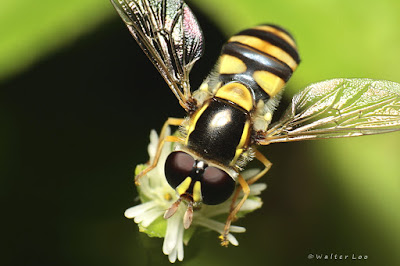Well, I actually do not have a backyard per se, since I stay in a government-subsidised HDB flat. However, there is a PCN (Park Connector Network) about 80 meters from where my flat is located. I do my jogging here, and if I could not find time travelling afar, this would be a good place to look for miniscure insects and bugs for macro photography.
The best time to photograph insects is the upper part of the morning. Being cooler, they are much slower in making an attempt to move away. Here are some specimens, including plants, that crossed my path this morning.
This stigma has some pollen on it (I hope I got this part of the flower anatomy right). Imagine a tube growing from these pollen into the base of the style, and eventually the male gametes (sperm cells) start travelling down to fertilize the ovary. The marvels of nature.
This weaver ant, together with many others are guarding their portion of the service road, where a few bright-yellow flowers are located. Obviously, they are up to something and I have to be careful not to step on them.
A close-up of one of the worker ants. This one with its abdomen up is definitely gearing for a fight. I think it spotted my lens and is all ready to protect its food source at all cost.
Another weaver worker ant on a dry leaf coming by.
These two ants are actually having a meal of pollen! It seems like these pollen are really sweet.
Yes. You guess it right. They are cutting up this petal and feasting on the sweetness of the petal, and the pollen of the flowers. It is really amazing to see their co-operative spirit in making sure there is food on the "table"!
A tiny snail on an equally small leaf. This snail is about 2.5mm across. It is just lazing about. Not moving much. Not tilting as well. Just staying still.
Close-up of a yellow creeping daisy flower. This flower is about 15mm across its petals. The stamens are about to open up completely. I just love seeing the intricate design of flowers.
Another great-looking yellow creeping daisy flower that is ready for the fertilization process. Here, we can see the anthers, as compared to the picture above.
A close-up of a flower from among the grasses on the grown.
Lynx spiders like to hide underneath leaves. This one is just across from another one that is twice its size. It is about 10mm from head to tip of the tail. Lynx spiders are known for being good hunters.
This looks like a meadow spittlebug. I am just guessing as I did not want to disturb it just to have a better view. A real tiny fellow, though.
Spider on a dried leaf.
A blooming flower.
A resting Genus Gesonia moth. The ends of the wings look beaten up but it can fly off quickly!
Mushrooms growing from a cut-off tree trunk. This trunk is fully covered by the cow grass and is largely unseen, unless one spreads the grass aside.
The under layer of a fallen bark.
A Hemigraphis reptans. Such a pleasant-looking little flower. It seems to stay low at the ground.
Close-up of a false daisy (Eclipta Prostrata) flower. It is a species of plants in the sunflower family.
A dead mite? Since it is lying in mid-air, it was probably trapped and killed by a spider. The tree moss is already so tiny, so I suppose the web is so fine that it was not picked up in this shot.
The seed of the false daisy (Eclipta Prostrata). It sure looks like a small version of the lotus flower seed. It is about 6 mm in diameter.
This hoverfly was flying from one flower to another. I waited for it to make a circle back to the nearest flower and took this shot. This fly is about 5mm long.
Found this black snail in the undergrowth of a bed of little plants. It is about 4mm across its shell.
It is morning now, so one can still see the left-overs of the early dew.
I like the pattern of this fallen leaf. This one is found in a perceptually wet grass-area. There are lots of large yellow-band millipedes. If ever my pet wants to change its diet, I know where to get them!
Another pattern that attracts me. A damp but dried leaf.
Looks like a bronzeback tree snake trying to swallow a bloated toad. As I surveyed closer, there were ants running around the toad, and it was bloated up. A bronzeback is a non-venomous snake.



























No comments:
Post a Comment